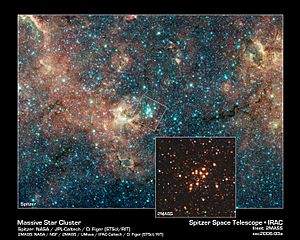RSGC1 facts for kids
Quick facts for kids RSGC1 |
|
|---|---|

Spitzer image of RSGC1
|
|
| Observation data (J2000 epoch) | |
| Constellation | Scutum |
| Right ascension | 18h 37m 58s |
| Declination | −06° 53′ 0″ |
| Distance | 22.0 ± 2.9kly (6.60 ± 0.89kpc) |
| Physical characteristics | |
| ~3 × 104 M☉ | |
| Estimated age | 10–14 my |
| See also: Globular cluster | |
RSGC1 is a very large and young group of stars, called an open star cluster, located in our own Milky Way galaxy. Scientists found it in 2006 by looking at data from special infrared telescopes. These telescopes can see light that our eyes cannot.
This cluster is special because it holds some of the biggest and brightest stars known. It is found in the direction of the Scutum constellation. RSGC1 is about 6,600 parsecs (which is about 22,000 light-years) away from our Sun.
Contents
What is RSGC1?
RSGC1 is an open star cluster. This means it's a group of stars that were all born around the same time from the same giant cloud of gas and dust. It is considered "young" in space terms, being only about 10 to 14 million years old.
Stars in the Cluster
RSGC1 is home to at least 12 very special stars called red supergiants. These are huge, bright stars that are much bigger than our Sun. They are in a late stage of their lives, burning helium in their cores.
The cluster also has one yellow hypergiant star. Hypergiants are even rarer and bigger than supergiants. There is also one star that is "intermediate," meaning it's somewhere between a supergiant and a hypergiant in size.
Size and Mass
RSGC1 is one of the most massive open clusters in our galaxy. Scientists estimate its total mass to be about 30,000 solar masses. A solar mass is a way to measure how much "stuff" is in something, using the Sun's mass as a unit. So, RSGC1 has the same mass as 30,000 Suns!
Where is RSGC1 Located?
This amazing star cluster is located in the Milky Way galaxy. It sits where the northern part of the galaxy's "Long Bar" meets the inner part of the Scutum–Centaurus Arm. The Long Bar is a long, straight shape of stars in the center of our spiral galaxy. The Scutum–Centaurus Arm is one of the Milky Way's two main spiral arms, like the arms of a giant pinwheel.
Why Can't We See It?
RSGC1 is "heavily obscured," which means it's hidden behind a lot of dust and gas in space. Because of this, we cannot see it with our eyes or with regular telescopes that use visible light. This is why scientists needed special infrared telescopes to find it. Infrared light can pass through dust clouds more easily than visible light.
Nearby Star Groups
RSGC1 is not alone in its part of the galaxy. It is close to other groups of red supergiant stars. These include clusters known as Stephenson 2, RSGC3, and Alicante 8.
What Happens Next?
The red supergiant stars in RSGC1 are very massive, about 16 to 20 times the mass of our Sun. Stars this big usually end their lives in a spectacular explosion called a Type II supernova. So, in the future, we might see some incredible cosmic fireworks from this cluster!

